This
is a five part series on the history of Winnipeg's Arlington Street
Bridge to commemorate the centenary of its opening on February 5, 1912.
Part 1: Spanning the Tracks
Part 2: Construction and Controversy
Part 3: The Bridge as "bugbear"
2023 UPDATE: End of the line for the Arlington Bridge?
Part 5: The Future of the Arlington Bridge
Back in February 2013, the city received a report, (that doesn't appear to be on the CCDMIS anywhere), which led them to downgrade the state of the 102 year-old Arlington Bridge's condition to poor and to begin the planning process to decommission it in 2020. That leaves them with just six years to come up an alternative and the CPR Yards Crossing Study is meant to find it.
On Thursday, December 4th, 2014 nearly 40 members of the public got together for the first public consultation meeting for that study. It consisted of a bus tour of three of the four crossings, (McPhillips Underpass, Arlington Street Bridge and Slaw Rebchuk Bridge, but not the Main Street Underpass), then it was back to Rossbrook House for a brief presentation and to do some community consultation activities.
At the start of the evening, it was said that everything was on the table but, that wasn't really the case.
The question of moving the CPR yards was verboten. That is being carried on by another group and was not to be considered as an alternative. (I couldn't help thinking, though, that if the city was to commit to spending, say, $50m on a new bridge plus 40 years of related maintenance costs, what would happen if they dropped a bag filled with $50 million on the CPR's doorstep - would it be an incentive to move if they added that to what other levels of government might kick in ?)
Another item not to be considered was retaining all or part of the existing bridge. Though it is the loads and vibrations of vehicle traffic that kills a bridge, removing vehicle traffic and rehabbing it for, say, a pedestrian / cycling / lookout area is not in the cards. The bridge IS coming down in 2020. It was mentioned, though, that the supports of the bridge were in good condition and could be used to support a new bridge deck.
The options on the table were to replace the old bridge with a new one, not replace it and upgrade an existing crossing(s) or to provide just a pedestrian link.
There were some interesting stats about traffic. Above is data I jotted down from the PowerPoint presentation that was given.
In terms of traffic flow, something of interest to folks like me who live around Arlington Street south of Notre Dame, is where traffic ends up. On the Slaw Rebchuk Bridge, for instance, over 40% of drivers heading southbound turn at Logan and another large batch do the same at William. For those traveling south on the Arlington Bridge, only 1% turn off. That tells me that whatever happens with the Arlington crossing has a big impact many blocks away, right to Portage Avenue.
Interestingly, the Slaw Rebchuk Bridge is the only unrestricted crossing between the North End and the rest of the city. The McPhillips Underpass, which gets the most traffic when the Arlington Bridge is closed, was constructed in the 1960s and is nearly two metres short of what would today be considered an acceptable clearance height for city traffic. Rebuilding that underpass could be an option, but at that site there is major underground infrastructure, including a pipe from the aqueduct, that would have to be relocated at great expense.
The main focus for this first consultation was to get to know the communities around the bridge. What did we use the bridge for ? What amenities did we cross the bridge to get to ? What alternatives would there be if there was either no bridge or an expanded bridge ?
The information will be used to build the second consultation session in early 2014 which will focus on bigger picture ideas about what to do about a new span.
It's old
The Arlington Bridge opened on February 5, 1912. Only the Redwood Bridge is older. The Louise was built at the same time but a opened a few of months earlier in 1911.
For this reason, and the usual maintenance issues when it comes to our older infrastructure, it doesn't surprise me that in the Arlington Bridge scored poor in several areas of the report.
There's no guarantee that the bridge is going to be replaced
The Arlington is basically a neighbourhood bridge. It doesn't connect to downtown or densely populated parts of the city. For a number of decades it has not even been a truck or bus route. Just two blocks to the south Arlington Street becomes a two-lane residential street from Notre Dame to Portage.
Given the length of the bridge and the fact that the city would likely want to replace it with something more robust with two additional lanes that can handle truck traffic, I'm guessing that we're looking a close to the $72m Esplanade Riel territory.
Infrastructure dollars for certain types of projects are scarce. Taking a look at the main roadworks projects on tap for the Public Works department, (or a wider range of projects from the last 5 years based on provincial funding, or the priorities set out in the city's 2013-1018 capital estimates), and you see a trend.
Most big ticket roadworks have been, and will be, geared toward new infrastructure in the suburbs, (the $18.5m Kenaston/IKEA widening), or ones that get people to and from the suburbs, ($17m Osborne Street Bridge, $195m Disraeli Bridges.) The major projects on tap for older parts of the city, neither in the core, are $7.5m to twin Molson Street and $30m for Polo Park traffic infrastructure.
I'm skeptical that a new Arlington Bridge is going to rocket to the top of the city's big-ticket infrastructure priorities any time soon.
The CPR Yards Relocation
Since 1972, there has been talk of moving the CP Yards that lie beneath the bridge. (Check out my history of that issue here.) This, too, could be an impediment to its replacement.
Even if this issue remains just talk, would the city want to outlay this type of money on a structure expected to last at least fifty years if there's a possibility that in twenty years time it might not be needed?
If the city does want a new bridge, they might first want to sit down with CP and offer them a bag of money with the construction costs of a new bridge as an incentive. This could get the discussion started, attract other levels of government, and save the city millions in maintenance costs in the decades to come.
Being a Realist
I am a realist when it comes to historic structures or buildings.
If the bridge is deemed to be at the end of its life as a vehicle bridge due to corrosion and simply too expensive (or even beyond) repair, it will sadly have to be taken out of service. Unlike tearing down a 100 year old building becasue you want more surface parking, bridges aren't something you can screw around with.
That being said, I hope that the city does not rush to conclusions. Mike Pagtakhan's argument that it should be torn down early as that will spur the redevelopment of a new span simply does not hold. If that was the case, our downtown would be filled with office buildings instead of pockmarked by surface parking lots.
A Best Case Scenario
I do have a soft spot for the Arlington Bridge. It has been a unique part of our skyline for over a century. It's also been a fighter, managing to outlast critics that date back to its planning stages and numerous reports that said it was at the end of its life.
If the rigours of thousands of tons of vehicles rattling over it every day is too much for it, I would like to see the city consider maintaining it for a much lighter use as a a pedestrian link as part of its active transportation plan. Of course further debate on what should happen to the bridge will be dependent upon the other parts of the study that have not been released yet.
It will be yet another interesting and controversial year for the Arlington Bridge.
From the "the more things change..." file
If you've read my bridge history, you know that the Arlington Bridge has been a controversial project right from its planning stages. It was likely bought "off the rack" as a rail bridge for a very different setting and just a couple of decades after opening began to corrode due to the smoke from the locomotives below.
Mike Pagtakhan is just the latest in a long line of city councilors who have called for the bridge's demolition. The first was Alderman John Blumberg, who died in 1961. As reported by the Winnipeg Tribune of July 30, 1946:
"The Arlington street bridge will always be a bugbear. It was built to go across the Nile River, but it was peddled off to the city of Winnipeg. The sooner the bridge comes down and a modern one goes up, the sooner will the city maintain expenses."
Mayor Steen was exasperated by the amount of time and money spent on various traffic studies over the years. He claimed that "The area had been studied to death." That was in 1978.
Wine Festival in Chattanooga (source)
Other Notable Truss Bridges
Considered by many to be the grand dame of large-scale truss bridges, the Firth of Forth Bridge in Scotland built in 1890.
The Walnut Street Bridge in Chattanooga, Tennessee also dates back to 1890 but with a niftier paint job ! It is was converted to a pedestrian-only bridge, said to be the world's longest.
The Arlington's sister bridge, (built by same company), over the Blue Nile in Khartoum opened in 1906.
The Pont du Quebec is considered the longest truss bridge in the world. It opened in 1919.
The Waibaidu (Garden) Bridge is a Shanghai landmark. It was built in 1907 but the cool lighting came after it was refurbished in 2009.
For More:
A History of the Arlington Bridge (2011 and currently being updated)
Part 1: Spanning the Tracks
Part 2: Construction and Controversy
Part 3: The Bridge as "bugbear"
Part 4: What about the Nile River connection
Part 5: The Future of the Arlington Street Bridge
Other posts and columns written by me
Moving the CP Yards, the early years West End Dumplings (2012)
The process to replace the Arlington Bridge has begun West End Dumplings (2014)
Bridging the Past Winnipeg Free Press 2015
Has the Arlington Bridge dodged another bullet? West End Dumplings (2020)
Arlington Street's great lengths Winnipeg Free Press (2022)
How many lanes does Arlington Street Have? West End Dumplings (2021)












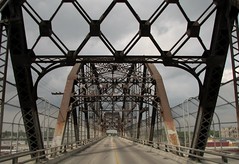
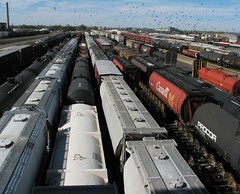


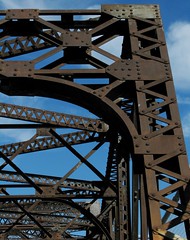
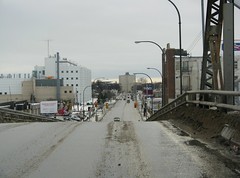

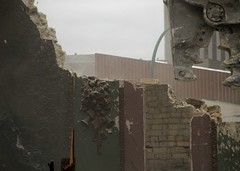



3 comments:
I suspect the approaches to this bridge win the contest for steepest incline in the City.
I have a soft spot for it too. For me, the steel trusses recall a time when steel had just replaced iron, which had earlier replaced wood. I always picture men swinging from the trusses installing the rivets and think back to the optimism at that time that Winnipeg would become a great city.
It's kind of neat that you loose radio reception when you drive over that bridge.
I like the look of the bridge too, but the railyards are an impediment to the city's future, and continue to separate the rich southerners from the more destitute North End. Get rid of the railyards and keep the bridge (though put it on the ground) as part of the new, green neighbourhoud
make it a pedestrian/cycling corridor that can be used for community events. It's beautiful, but also a critical link for those in the North End -- I suspect more people walk over this bridge than any other in the city.
Post a Comment